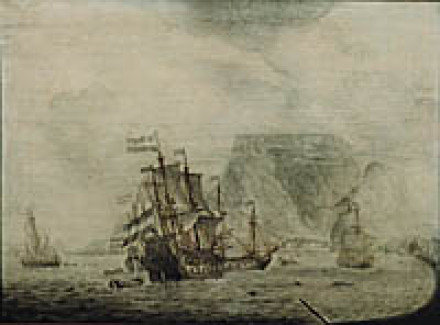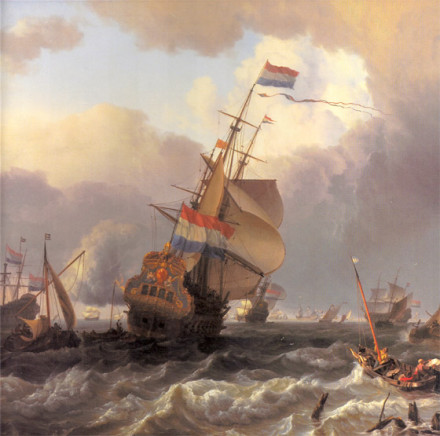History
The Reigersdaal was an East Indiaman sailing for the VOC as a merchant vessel between the Netherlands and the East Indies. She left in May of 1947 from Texel under the command of Johannes Band. On board were 297 people, of whom most would die during the voyage to the East. During their voyage, about 125 men died of scurvy by the time they reached the Cape, and an additional 83 men were too weak to work. Upon arrival, they could not anchor due to the weather and the ship had to wait in the bay for the night.
When they raised the anchor the next day, the cable broke. About 15 men climbed into a boat in an attempt to take a line ashore. But less than an hour later, when they had reached the shore, they saw that the Reigersdaal had been smashed to pieces. 157 men died when the Reigersdaal hit a reef near Springfontein Point on 21 October 1747 between Robben Island and Dassen Island. In total, only 20 people who were onboard the Reigersdaal ever made it to Cape Town alive. The bodies of those who did not survive was reportedly buried near the mouth of the Bockerivier.
A few days after the loss of the Reigersdaal one chest of silver was found on the shore.

Description
The Reijgersdaal was a Dutch East Indiaman (spiegelretourschip) built in 1738 in Amsterdam for the Amsterdam Chamber of the VOC.

| Skipper | Johannes Band |
|---|---|
| People on board | 297 |
| Length | 145 Amsterdam feet (41.1 m) |
| Tonnage | 850 ton (425 last) |
Status
The wreck was discovered by a South African Salvage team led by Brian Clark and Tubby Gericke in 1979. They managed to salvage six large bronze cannons adorned with beautiful carvings and the crest of the Amsterdam Chamber of the VOC. Lead ingots were also salvaged from the wreck site.
A permit was also issued by the National Monuments Council for salvage work to be undertaken, upon which some silver coins were found. As news of the wreck spread, many people came to work on the site and approximately 20 000 silver coins were recovered during the 1980s. Other salvors attempted to recover valuable items from the wreck with success. Jimmy Rawe and Arthur Ridge recovered about 7000 coins from the site, most of them Mexican pillar dollars.
At some point it was blasted with dynamite to loosen some of the conglomerate that contained the silver coins. At times, a helicopter was even used to lift some of the coin-containing conglomerate out of the ocean. As a result, much of the archaeological context of artefacts from this wreck was lost in the rush to extract the silver coins. However, several iron cannons and two anchors are still left at the site.
Sadly, the wreck of the Reigersdaal apparently claimed one more life when a diver collected too many items and drowned because they could not reach the surface.
No professional archaeological research has been done on the Reigersdaal, in part due to the challenging conditions that persist at the site. The wreck has also sustained a lot of damage from the explosives that were used to recover the coins.

Some of the Material from the Reigersdaal is held at:
- Iziko Museums (Cape Town)
- The Shipwreck Museum (Bredasdorp)
- Bayworld Museum (Gqeberha)
- Simon’s Town Naval Museum
- Simon’s Town museum.
Cannons from the Reigersdaal are displayed in the Simon’s Town Naval Museum and the Shipwreck Museum in Bredasdorp.

Some artefacts remaining from the Reigersdaal, and which were donated to Iziko Museums, include coins and a bronze cannon. A bronze cannon was also donated to the Bayworld Museum in Gqeberha
The wreck site of the Reigersdaal is protected in terms of the National Heritage Resources Act, No. 25 of 1999. This act regards historic shipwrecks as well. They may not be disturbed without the permission of the South African Resources Agency (SAHRA) and artefacts removed from the wreck may not be traded without SAHRA's permission.

References
- Dagregister Kaap (27-10-1747.
- 1.11.01.01.551 Lijst van alle zoodanige Schepen, fol. 150.
- Lesa la Grange, Martijn Manders, Briege Williams, John Gribble and Leon Derksen (2024).
Dutch Shipwrecks in South African Waters: A Brief History of Sites, Stores and Archives [Unpublished].